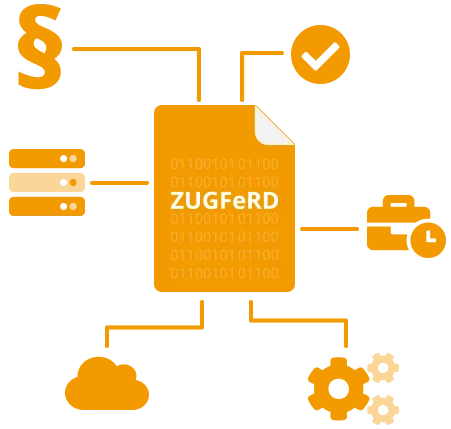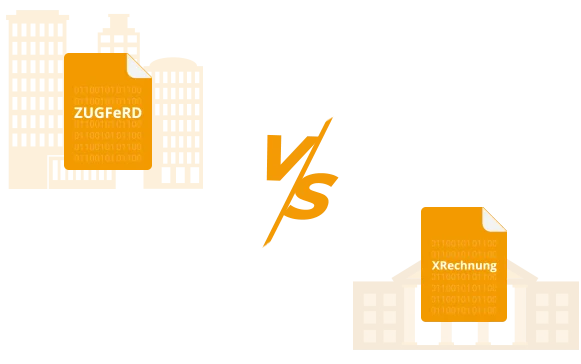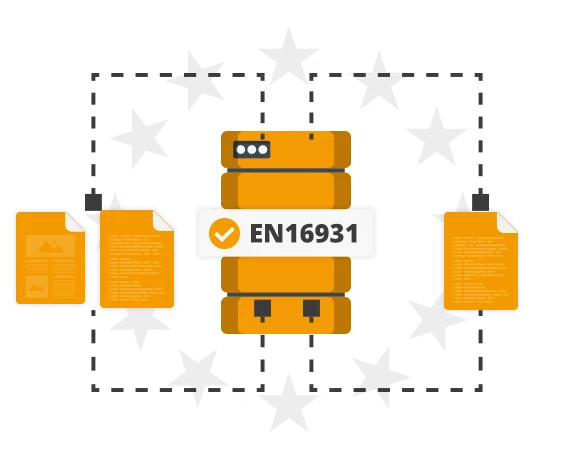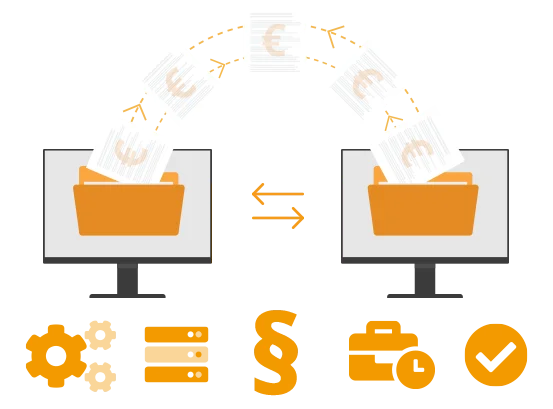What is a ZUGFeRD invoice?
ZUGFeRD is a hybrid data format consisting of a PDF container part (PDF/A-3) and an embedded XML component. Files of this type are used in the context of EDI (electronic data interchange) in order to cover the area of e-invoicing as simply and easily as possible and thus make it attractive to a wider range of users. It is therefore intended to contribute to the increased use and distribution of electronic invoices apart from paper invoices and simple PDFs, primarily in the B2B sector.
Origin and meaning of ZUGFeRD
On the initiative of the German Federal Ministry for Economic Affairs and Energy and the Working Group for Economic Administration, ZUGFeRD was defined and developed by the "Forum elektronische Rechnung Deutschland" (FeRD), from which the format name is also derived: Central User Guide Forum Electronic Invoice Germany. Starting from the first considerations in 2010, the intermediate step of version 1.0 (2014) resulted in version ZUGFeRD 2.1 (2020), which is now also EN16931 compliant. This means that ZUGFeRD files are also suitable and approved to meet the so-called supplier obligation: Since the end of November 2020, invoices to the federal government may only be issued in electronic form. Read more about this topic in the blog article "Deadline for XRechnung: 27.11.2020".

How does ZUGFeRD work?
Better safe than sorry. With a ZUGFeRD (invoice) file, you transmit your invoice data both in human-readable form, PDF/A-3, and in a structured, standardized and consequently machine-readable way in XML format. It goes without saying that you must ensure that both parts of the file are identical. An example from our daily work:

You fill in an unambiguous data source, e.g. a database. From this unambiguous information, on the one hand the image-based PDF part is generated according to the company-specific corporate design, and on the other hand the XML file clearly described by the ZUGFeRD definitions. There are currently three different versions available: Basic, Comfort (EN16931) and Extended. Depending on the requirements of the sender and/or recipient, a profile is agreed upon. Last but not least: Whether the recipient uses the PDF or the XML part is up to the respective individual invoice verification process, both are possible.
What advantages does ZUGFeRD offer?
Established EDI processes, like all digitization efforts, offer many advantages. In particular, e-invoicing as a sub-discipline of electronic data interchange enables significant benefits for companies of all sizes:
No vote necessary:
EDI processes and the use of EDIFACT, UBL, openTRANS and CO. are often said, rightly or wrongly, to be time-consuming in the individual coordination with the communication partner. ZUGFeRD actually offers the advantage that this e-bill is rigidly defined within the framework of the structure and profile specifications of FeRD. Thus, when using this file format, it is clearly documented for both the sender and the recipient which data is sent or received.
Process optimization:
The processing of incoming and outgoing invoices can be digitally (partially) automated away from traditional, analog invoice processing on paper. When using the XML part, it can lead to invoice processes completely without human intervention.
Cost Reduction:
Sending paper documents is often more time-consuming than one might think. From the procurement of paper as a raw material, to the capture and printing of invoices, to postal dispatch and processing, as well as archiving on the addressee side, humans are still involved in many cases today. Thus not insignificant costs are caused. With the use of ZUGFeRD, processes can be significantly streamlined.
Environmental protection:
You use less paper, which is equally less transported by vehicles to your destination. Thus, the use of e-invoicing and ZUGFeRD contributes to a conscious use of available resources.
Flexibility:
With the introduction of electronic invoicing, e.g. in ZUGFeRD format, they are clearly more flexible in their day-to-day work. Theoretically and practically, access to electronic invoices is possible anytime and anywhere when using mobile devices on the road or in the home office.
XRechnung vs. ZUGFeRD
The two buzzwords ZUGFeRD and XInvoice often fall under the umbrella term e-invoicing. There are two main differences between these two data formats.

B2B vs. B2G
As already described above, ZUGFeRD is in the making and still a data format for the business-to-business sector. It is intended to contribute to greater acceptance and dissemination of e-invoices and a reduction in paper invoices through simplification and streamlining. XRechnung, on the other hand, is a data format developed expressly for the B2G sector for transmitting invoice information to the administration (federal and state governments). XRechnung complies with EN16931, i.e. it is a Germany-specific CIUS (Core Invoice Usage Specification), i.e. the national version of EN16931 in Germany.

Hybrid formats vs. native formats
While ZUGFeRD represents a hybrid data format through the PDF container with embedded XML file, XInvoice is represented exclusively by an XML file, i.e. it has no visual part. This is explicitly described in the corresponding regulation ERechV.
However, it is important to note that both data formats now comply with the aforementioned EN16931 and are therefore theoretically permissible for invoicing federal and state governments.
Why create invoices in ZUGFeRD format?
ZUGFeRD is an interesting data format equally for large, medium and especially small companies. Various perspectives play a role in this evaluation.
From the point of view of larger companies, ZUGFeRD will probably be "just" another data format in the overall EDI concept, since it is ultimately just another XML structure that is exchanged with suppliers or customers. In this respect, the implementation for such scenarios will also be less of a task and can be easily integrated within the framework of existing EDI processes.

From the perspective of smaller companies, the topic has a special charm. Often, no e-invoicing is in use there at all and only postal and paper delivery is used. Therefore, ZUGFeRD as a hybrid, clearly defined data format is an easy entry into the digitization of business processes. However, if at least the exchange of simple PDF invoices has already been implemented, the switch and extension to ZUGFeRD can be an interesting improvement. On both the input and output side, the e-invoice format ZUGFeRD can replace many process steps and optimize the invoice run. Since in the vast majority of cases at least simple enterprise resource planning systems - which should be able to create and receive ZUGFeRD - will be in use, in the meantime even the automated processing of the XML parts will be possible for a large part of the application areas.

Contact
We will be happy to advise you personally and compile
an individual concept with you. Request now without obligation.
